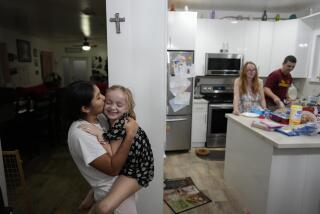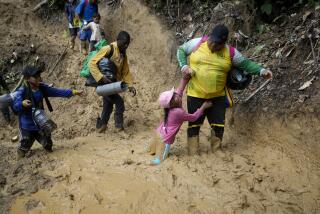Streets Mean, but Glimmer of Hope in U.S.
- Share via
NEW YORK — Youngsters sell sex on America’s streets, hustle in the bars of high-class hotels, pose at the peep shows. Often, they don’t have to be there--or they didn’t when they started.
While desperate poverty drives Third World children into sexual bondage, young prostitutes in the United States are more likely to be runaways. They’re rebellious and they’re seeking independence, but the life is the same as in the developing world: Trading sex for survival.
“When you’re cold and hungry, perhaps you do a lot of things that you wouldn’t do otherwise at the age of 13, and slowly it becomes a way of life,” said Daniel Armagh of the National Center for the Prosecution of Child Abuse.
UNICEF estimates at least 100,000 children in the United States are prostitutes. Most of them first suffered physical, sexual or emotional abuse at home.
Now they work the streets, bars, massage parlors and escort services and take roles in the booming pornography business. They’re in big cities and in small towns.
“It’s something that this country does not want to face because we’re not supposed to have this situation,” said Frank Barnaba, the founder of Paul & Lisa, a private, Connecticut-based group that works with exploited girls and women. Barnaba spends his nights cruising the streets of New York, trying to win the trust of young women and get them off the street.
Prostitution is often a short-term career, given the prevalence of AIDS, tuberculosis, hepatitis and addictive drugs.
Maxine Shoulders, director of the crisis center at New York’s Covenant House, helps young people who are in bad shape, with no place to go. At Covenant House, the kids talk about how a boyfriend prostituted them for drug money, or a relative molested them, robbing them of self-esteem.
Once teens hit the street, a pimp befriends them, filling their terrible need for an adult who cares. “They don’t know enough to fear people,” said Lt. Bill Walsh of the child-exploitation unit in the Dallas Police Department. “Once they’re in it, they realize that this person didn’t have their best interests at heart.”
But options for escape are limited. Shelters don’t have enough food or beds. Cops often treat the kids as criminals rather than abused children. If they were abused at home, they’re not likely to go back willingly.
But they’re not likely to last long out there. “By the time they’re 16 or 17, they look like they’re in their 30s,” Armagh said.
There is still a difference between American child prostitutes and their counterparts from Eastern Europe or Southeast Asia or Africa, said Toby Tyler of the sheriff’s department in San Bernardino County.
“The children who are victimized by child prostitution in the Third World have no hope, while the children in America have some hope,” he said.
More to Read
Sign up for Essential California
The most important California stories and recommendations in your inbox every morning.
You may occasionally receive promotional content from the Los Angeles Times.













